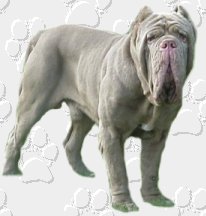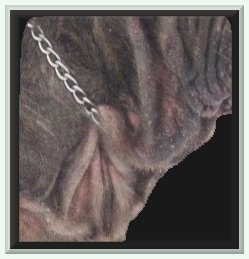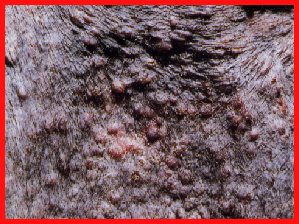

 |
 |
| Demodectic mange occurs in one of
two forms; Localized and Generalized.
Demodectic mange (also known as red mange, follicular mange, or puppy mange) is a skin disease, generally of young dogs caused, by the mite, Demodex canis. It may surprise you to know that this same mite lives, without causing any harm or irritation, on the bodies of virtually every adult dog and most human beings. These small (0.25 mm) "alligator-like" mites live inside of the hair follicles (i.e., the pore within the skin through which the hair shaft comes through), hence the name follicular mange. In humans, the mites usually are found in the skin, eyelids and the creases of the nose. Whether or not Demodex causes harm to a dog depends on the animal's ability to keep the mite under control. Demodectic mange is not a disease of poorly kept or dirty kennels. It is generally a disease of young dogs that have inadequate or poorly developed immune systems or older dogs that are suffering from a depressed immune system. What is the life cycle of Demodex canis? The demodectic mite spends it's entire life on the dog. Eggs are laid by a pregnant female, hatch, and then mature from larvae to nymphs to adults. The life cycle is believed to take 20-35 days. How is Demodex canis transmitted? The mites are transferred directly from the mother to the puppies within the first week of life. Transmission of the mites is by direct contact only. That is, the mother and puppy must be physically touching, as the parasite cannot survive off of the animal. This is important because it means the kennel or bedding area does not become contaminated and therefore the environment need not be treated. Lesions, if present, usually appear first around the puppy's head, as this is the area most in contact with the mother. Virtually every mother carries and transfers mites to her puppies. Most puppies are immune to the mite's effects and display no clinical signs or lesions. A few are not immune and it is these that develop into full-blown cases of mange.
Individuals that are sensitive to the mange mites may develop a few (less than 5) isolated lesions (localized mange) or they may have generalized mange in which case there are more than 5 lesions involving the entire body or region of the body. Most lesions in either form develop after four months of age. The lesions and signs of demodectic mange usually involve hair loss, crusty, red skin and at times a greasy or moist appearance. The mites prefer to live in the hair follicles, so in most cases hair loss is the first noted sign. Usually hair loss begins around the muzzle, eyes and other areas on the head. In localized mange, a few circular crusty areas will be noted, most frequently around the muzzle. Most of these lesions will self heal as the puppies become older and develop their own immunity. Persistent lesions will need treatment that will be described later. In cases in which the whole body is involved (generalized mange) there will be areas of hair loss over the entire coat, including the head, neck, abdomen, legs and feet. The skin along the head, side, and back will be crusty and often times inflamed. It will often crack and ooze a clear fluid. Hair will be scant, but the skin itself will often be oily to the touch. Some animals can become quite ill and develop a fever, lose their appetite and become lethargic. Patients with generalized demodectic mange need immediate vigorous treatment.
How is demodectic mange diagnosed? Once Demodectic mange is suspected it can usually be confirmed by a skin scraping or biopsy in which the mites can be seen with the aid of a microscope. They are too small to be seen with the naked eye. The adults appear as tiny alligator-like mites. Remember that these mites are present in every dog so by themselves they do not constitute a diagnosis of mange. The mite must be coupled with the lesions for a diagnosis of mange to be made. How is demodectic mange treated? The treatment of Demodectic mange is usually accomplished with lotions dips and shampoos. Fortunately 90% of demodectic mange cases are localized in which only a few small areas are involved and can often be treated topically. A treatment that has been successful for years has been a 1% rotenone ointment (Goodwinol ointment) or more recently a 5% benzoyl peroxide gel applied daily. Or Tactin is commonly used. And treated by 3ml. to 1 gal. of water mixed applied to a clean cloth or sterile gauze general use sponges, And applied liberally to effected areas. Treat again in 3 days. Bathing periodically with a benzoyl peroxide shampoo and feeding a high quality diet and a multi vitamin with a fatty acid may also help some dogs. Most of these localized lesions will heal on their own and do not require overly aggressive treatment.
If a dog develops generalized demodicosis more aggressive treatment is usually required. Studies show that between 30% and 50% of dogs that develop the generalized form will recover on their own without treatment but treatment is still always recommended for the generalized form. The treatment of choice continues to be Amitraz dips applied every two weeks. Amitraz is an organophosphate and is generally available under the product name Mitaban. It is a prescription product and should be applied with care. Humans should always wear rubber gloves when applying it to their dog, and it should be applied in an area with adequate ventilation. It is recommended that longhaired dogs be clipped short so that the dip can make good contact with the skin. Prior to dipping, the dog should be bathed with a benzoyl peroxide shampoo to help remove oil and cellular debris. Most dogs with generalized demodicosis require between 4 and 14 dips. After the first three or four dips a skin scraping should be performed to determine if the mites have been eliminated. Dips should continue until there have been no mites found on the skin scrapings taken after 2 successive treatments. Some dogs develop sedation or nausea when dipped and toy breeds in particular are sensitive to amitraz. Half strength dips should be used on these sensitive animals. Ivermectin should not be used in collies and similar breeds. Some dogs may not respond to this treatment and the frequency of the dips may have to be increased or additional treatments may need to be instituted. Recently, two new products have been used to help treat demodicosis. These products are not FDA approved for the treatment of demodectic mange, but are being widely used by veterinary dermatologists and general practitioners with some good results. Ivermectin is a broad-spectrum de-worming agent that is available in a 1% solution for cattle. Ivermectin is the active ingredient in Heart Guard, however the concentration in Heart Guard is not high enough to be effective against Demodex. The liquid ivermectin should only be used under close veterinary supervision. Another drug, Milbemycin oxime, (Interceptor) has also been given daily and been shown to be effective on up to 50% of the dogs that did not respond to Mitaban dips. 1 cc. Ivermectin use once a day for 3 days, after the Ivermectin treatment is completed, in case of a Staff infection follow up with a strong antibiotic such as Augmentin. Dogs that have generalized demodicosis often have underlying skin infections so antibiotics are often given for the first several weeks of treatment. In addition we usually recommend the dog be put on a good multi-vitamin/ fatty acid supplement. Because Demodex flourishes on dogs with a suppressed immune system it is wise to check for underlying causes of immune system disease, particularly if the animal is older when they develop the condition.
Prognosis and impact on breeding : Demodectic mange is not an inherited condition but the suppressed immune system that allows the puppy to be susceptible to the mites can be. Remember that all puppies receive the mites from their mother but only a few have ineffective immune systems and develop the mange. This sensitivity can be passed genetically through generations. Individuals that have a history of demodectic mange, and their parents and siblings, should not be bred. Through careful breeding most cases of generalized Demodicosis could be eliminated. Can I get Demodex from my dog? The various species of Demodex mites tend to infest only one species of host animal, i.e., Demodex canis infests dogs, Demodex bovis infests cattle, and Demodex folliculorum infests humans. In conclusion, a few important points should be repeated. The mites are transferred from the mother to offspring in the first few days of life. The first sign of hair loss usually does not occur until after four months of age. Demodectic mange is almost always curable or controllable with persistent treatment except in rare cases with very immune suppressed individuals. The immune system condition that allows for the development of demodectic mange can be an inherited condition and breeding of these animals should not occur. Some females get the disease each time they come into heat. In between heats they are "OK". Spaying them often takes care of the problem. Some males get localized demodex and pustules on their chins and dewlap area as they reach puberty. Some puppies with persistent demodex, just wont go away. Until they reach 2 yrs of age and it just disappears for good. Generalized demodectic mange must be treated under veterinary supervision. Older dogs that develop demodectic mange (in either form) should be screened for underlying causative factors in immune system dysfunction. Diseases such as diabetes, cancer or cushing's disease can all impact therapy. If you look close at some of most beautiful Mastini in the world, you will find the pustules and puffy lips, Characteristics of demodex in the dewlap. In relativity the demodecosis inflammation thus making the dewlap look fuller thicker and more impressive looking. When inflammation affects the feet, it also makes them bigger and more impressive looking. There are huge, grotesque looking Mastini who do not have demodex. Demodecosis is worth while goal to bred out of the Neapolitan Mastiff. The emotional and economic toll demodex takes on owners of Neo's, Not to mention the irritation it causes to the dog. Are reasons to eliminate it!
|
 |